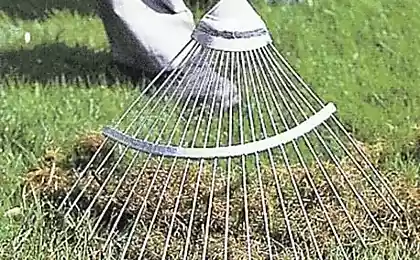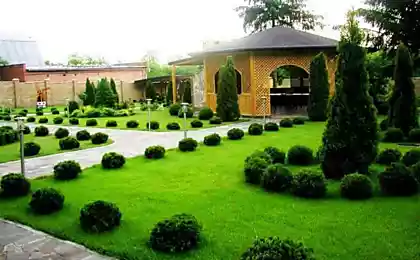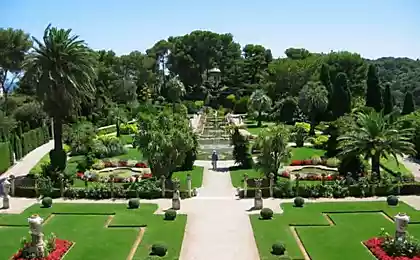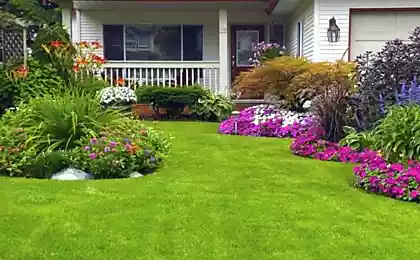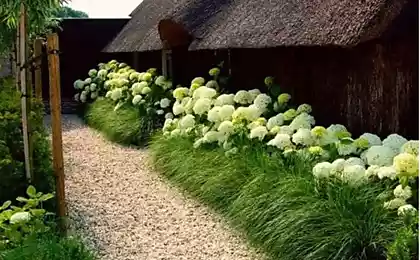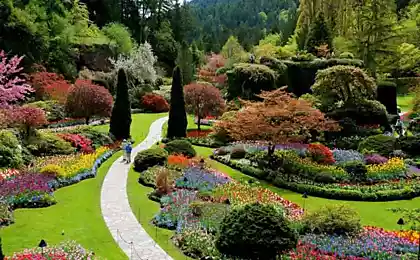196
An extraordinary solution - decorative vegetables on the lawn
Recently, the owners of cottages, following the modern trends of design, often seek to use the most ceremonial part of the estate (in front of the house) for the arrangement of lawns. And this is not accidental, because properly arranged and well-groomed lawn with juicy greenery is a decoration of the cottage, a good background for trees, shrubs and flower crops, a beautiful recreation area, peace for the eyes, as well as a real “sanitary”, which absorbs dust, noise, cleans the soil, regulates the microclimate of the site.
For those who still can not abandon the garden, but already "sees" in his dacha aristocratic English lawn, you can offer a compromise option. Its essence is to, without harming the lawn itself, place edible ornamental plants on it. In addition to the utilitarian purpose, single or group plantings, flower and vegetable beds, curbs will create the necessary diversity on the lawn and its surface will not seem monotonous and boring.
The experienced summer resident will understand that in this case we are talking about a classic lawn, which is not intended for sports games and differs from the motley meadow by another plant composition that creates an exclusively green surface.
In order to break a flower-vegetable grass, arabesca or flowerbed on the lawn, it is necessary to first completely sow the lawn, after rooting the cereals, cut the sod of a certain area and outline, then plant plants on the prepared soil.
A beautiful decoration of the lawn can be groups, flower beds, arabesques made of chard beet, salads, cabbage, vegetable chrysanthemums, serpent tile, long-leaf veronics, river gravilate, brown-yellow lily, bells.
An unexpected, but spectacular solution will be the location on the lawn of decorative pumpkins with large golden flowers and brightly colored fruits, as well as bushy forms of zucchini and squash.
Some plants, for example, primrose, salads, yellow-tiled chard, calendula, velvets, etc., it is appropriate to apply in the fringe of the lawn. Moreover, such a edging will allow you to decorate its uneven edges formed during border haircut, which usually have to trim with scissors manually.
A unique edible plant is clover, which is part of many lawn mixtures. Therefore, it is not necessary to grow it specifically for food. It is enough to approach the overgrown lawn and rip off appetizing young leaves.
There are different opinions about the accidental colonization of the lawn by other plants. So, dandelion, daisy, veronica are considered his unwanted guests, who over time can displace the main herbal composition. However, if you eat their young greens or roots (dandelion), clogging of the lawn can be avoided. Moreover, timely haircut prevents the insemination of so-called weeds. And careful digging of roots with a special garden tool will not damage the sod. Observing these precautions, you can, without fear for the safety of the lawn, enjoy the first spring flowering.
There are cases when I would like very much, but there is no possibility to arrange a lawn: for example, rocky slopes, very shady wet or, conversely, heavily lit dry places prevail on the site. Then the soil cover plants of the corresponding habitats can come to the rescue, forming carpets or short (up to 30 cm), dense extensive curtains. Of course, in resistance to trampling, they are inferior to special lawn mixtures, but with a small load quickly cover the ground with a flowering carpet. In the assortment of edible plants for this purpose are suitable: ordinary sour, nasturtia large, sliver creeping, thyme creeping, white-filled bunber, ivy-shaped budrum, clover creeping others. The main thing is to place certain plants taking into account their requirements for light, water, soil.
Source: www.7dach.ru
For those who still can not abandon the garden, but already "sees" in his dacha aristocratic English lawn, you can offer a compromise option. Its essence is to, without harming the lawn itself, place edible ornamental plants on it. In addition to the utilitarian purpose, single or group plantings, flower and vegetable beds, curbs will create the necessary diversity on the lawn and its surface will not seem monotonous and boring.
The experienced summer resident will understand that in this case we are talking about a classic lawn, which is not intended for sports games and differs from the motley meadow by another plant composition that creates an exclusively green surface.
In order to break a flower-vegetable grass, arabesca or flowerbed on the lawn, it is necessary to first completely sow the lawn, after rooting the cereals, cut the sod of a certain area and outline, then plant plants on the prepared soil.
A beautiful decoration of the lawn can be groups, flower beds, arabesques made of chard beet, salads, cabbage, vegetable chrysanthemums, serpent tile, long-leaf veronics, river gravilate, brown-yellow lily, bells.
An unexpected, but spectacular solution will be the location on the lawn of decorative pumpkins with large golden flowers and brightly colored fruits, as well as bushy forms of zucchini and squash.
Some plants, for example, primrose, salads, yellow-tiled chard, calendula, velvets, etc., it is appropriate to apply in the fringe of the lawn. Moreover, such a edging will allow you to decorate its uneven edges formed during border haircut, which usually have to trim with scissors manually.
A unique edible plant is clover, which is part of many lawn mixtures. Therefore, it is not necessary to grow it specifically for food. It is enough to approach the overgrown lawn and rip off appetizing young leaves.
There are different opinions about the accidental colonization of the lawn by other plants. So, dandelion, daisy, veronica are considered his unwanted guests, who over time can displace the main herbal composition. However, if you eat their young greens or roots (dandelion), clogging of the lawn can be avoided. Moreover, timely haircut prevents the insemination of so-called weeds. And careful digging of roots with a special garden tool will not damage the sod. Observing these precautions, you can, without fear for the safety of the lawn, enjoy the first spring flowering.
There are cases when I would like very much, but there is no possibility to arrange a lawn: for example, rocky slopes, very shady wet or, conversely, heavily lit dry places prevail on the site. Then the soil cover plants of the corresponding habitats can come to the rescue, forming carpets or short (up to 30 cm), dense extensive curtains. Of course, in resistance to trampling, they are inferior to special lawn mixtures, but with a small load quickly cover the ground with a flowering carpet. In the assortment of edible plants for this purpose are suitable: ordinary sour, nasturtia large, sliver creeping, thyme creeping, white-filled bunber, ivy-shaped budrum, clover creeping others. The main thing is to place certain plants taking into account their requirements for light, water, soil.
Source: www.7dach.ru


